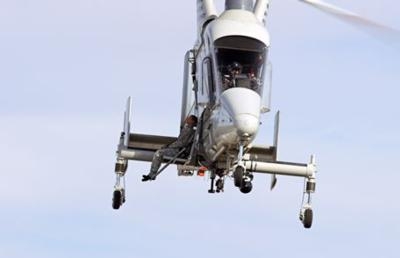Mon, May 04, 2015
Demonstration Conducted Late Last Month By K-MAX, LMC
Dangerous frontline operations call for a safe and efficient method to locate and evacuate wounded personnel. To address this critical need and help save lives, Lockheed Martin, Kaman Aerospace, and Neya Systems demonstrated the first ever collaborative unmanned air and ground casualty evacuation using the unmanned aerial system (UAS) control segment architecture and K-MAX cargo helicopter on March 26.

During the demonstration, a distress call led ground operators to send an unmanned ground vehicle to assess the area and injured party. The ground operators used control stations that communicated with one another using the UAS control segment architecture. Upon successful identification, the ground operators requested airlift by unmanned K-MAX of one individual who was injured. From the ground, the K-MAX operators used a tablet to determine the precise location and a safe landing area to provide assistance to the team. The injured team member was strapped into a seat on the side of the unmanned K-MAX, which then flew that individual to safety.
"This application of the unmanned K-MAX enables day or night transport of wounded personnel to safety without endangering additional lives," said Jay McConville, director of business development for Unmanned Integrated Solutions at Lockheed Martin Mission Systems and Training. "Since the K-MAX returned from a nearly three-year deployment with the U.S. Marine Corps, we've seen benefits of and extended our open system design incorporating the UAS control segment architecture, which allows rapid integration of new applications across industry to increase the safety of operations, such as casualty evacuation, where lives are at stake."
"Neya is continuing to develop advanced technologies for human robot interfaces for complex platforms and multi-robot missions," said Dr. Parag Batavia, president of Neya. "Our and Lockheed Martin's use of the unmanned aircraft system control segment architecture greatly sped up integration of our respective technologies, resulting in a comprehensive capability that can be ultimately transitioned to the warfighter very efficiently."
While deployed with the U.S. Marine Corps from 2011 to 2014, unmanned K-MAX successfully conducted resupply operations, delivering more than 4.5 million pounds of cargo during more than 1,900 missions.
(Image provided by Lockheed Martin)
More News
Aero Linx: Transport Canada We are a federal institution, leading the Transport Canada portfolio and working with our partners. Transport Canada is responsible for transportation p>[...]
Gross Navigation Error (GNE) A lateral deviation from a cleared track, normally in excess of 25 Nautical Miles (NM). More stringent standards (for example, 10NM in some parts of th>[...]
From AirVenture 2017 (YouTube Edition): Flight-Proven Booster On Display At AirVenture… EAA AirVenture Oshkosh is known primarily as a celebration of experimental and amateu>[...]
Aircraft Parachute System (CAPS) Was Deployed About 293 Ft Above Ground Level, Which Was Too Low To Allow For Full Deployment Of The Parachute System Analysis: The day before the a>[...]
Also: 48th Annual Air Race Classic, Hot Air Balloon Fire, FAA v Banning 100LL, Complete Remote Pilot The news Piper PA-18 Super Cub owners have been waiting for has finally arrived>[...]
 ANN's Daily Aero-Linx (06.29.25)
ANN's Daily Aero-Linx (06.29.25) ANN's Daily Aero-Term (06.29.25): Gross Navigation Error (GNE)
ANN's Daily Aero-Term (06.29.25): Gross Navigation Error (GNE) Classic Aero-TV: Anticipating Futurespace - Blue Origin Visits Airventure 2017
Classic Aero-TV: Anticipating Futurespace - Blue Origin Visits Airventure 2017 NTSB Final Report: Cirrus SR22
NTSB Final Report: Cirrus SR22 Airborne Affordable Flyers 06.26.25: PA18 Upgrades, Delta Force, Rhinebeck
Airborne Affordable Flyers 06.26.25: PA18 Upgrades, Delta Force, Rhinebeck



